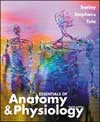NEW IN THE FOURTH EDITION Each new edition causes one to think furiously about what changes should be
made to improve the text. Because new information is steadily discovered by
thousands of researchers, it is important to determine what new information
and what changes should be included in the text. For example, molecular techniques
have led to a better understanding of the way molecules released from some cells
bind to molecules in the membranes of other cells and stimulate a response.
This information clarifies our understanding of how nerve cells communicate
with other nerve cells and with muscle cells to produce a specific response.
It makes it easier to understand how hormones and other extracellular signal
molecules affect the activities of target cells. Simply increasing the amount
of information in a text in response to new discoveries is not always necessary.
Frequently, the new information makes concepts clearer and more easily explained.
The topics we chose to expand upon in light of new information, clarify based
on reviewer feedback, or add for depth of coverage are listed below: - Chapter 2-Information about the chemical structure of phospholipids and
steroids has been added.
- Chapter 3-A clearer description of the structure of the cell membrane, additional
information about the function of the smooth endoplasmic reticulum, and new
information about peroxisomes and production of mitochondria has been presented.
Information about cystic fibrosis has been added to emphasize the importance
of small changes in genetic material, their potential effects on protein structure,
and their dramatic consequences.
- Chapter 4-New histology figures have been added to make the categorization
of epithelial tissues and connective tissues clearer, and a more thorough
description of dense collagenous connective tissue has been added.
- Chapter 5-The most current information about nutrition and the integumentary
system has been added, as well as new findings regarding the effects of different
ultraviolet light (UVA and UVB) on the skin and their potential for causing
skin cancer.
- Chapter 7-Current information about slow-twitch and fast-twitch muscle fibers
and the impact of exercise on them is presented, and muscle tables have been
updated to more thoroughly describe skeletal muscle anatomy.
- Chapter 8-New sections on the knee-jerk and withdrawal reflexes have been
added, along with additional information on spinal cord injury and treatment
and current information about treatments for Parkinson's disease, strokes,
and Alzheimer's disease.
- Chapter 10-New information on receptors, both intracellular and membrane
bound, clarifies understanding of how cells communicate and how extracellular
signal molecules regulate the activities of cells. A more thorough explanation
of prostaglandins presents the subcategories of eicosanoid compounds.
- Chapter 11-A clearer explanation of platelet plug formation and factors
that control prothrombin time are presented. The term "erythrocyte"
has been replaced with "red blood cell" throughout the book to make
the terminology more commonplace and more consistent with the use of terms
in clinical settings.
- Chapter 12-Updated information on action potentials in cardiac muscle and
the effect of plasma calcium and potassium levels on cardiac muscle function
is presented. In addition, there is new information on the heart rate and
the effect of exercise on cardiac output.
- Chapter 14-Updated information on the size of the thymus in people of various
ages and on immunotherapy for breast cancer has been included.
- Chapter 15-Information on the vital capacity of the lung in different groups
of people has been expanded.
- Chapter 16- Important clinical information pertaining to pathologies of
the digestive system such as hiatal hernia, hypertrophic pyloric stenosis,
appendicitis, inflammatory bowel disease, Crohn's disease, ulcerative colitis,
and irritable bowel syndrome has been added.
- Chapter 17-Current information is presented on recommended daily allowances
(RDA), daily values, and other nutritional recommendations.
- Chapter 18-Explanations of filtration pressure and reabsorption have been
further clarified.
- Chapter 20-New information about ATP production with aging, mitochondrial
DNA and mutations in the mitochondrial DNA, and tumor suppression genes is
presented.
Creative efforts can improve explanations and illustrations, which in turn
leads to better organization of concepts and better explanations of functions.
Finding ways to improve explanations and creating examples to illustrate them
takes a great deal of time. For the fourth edition, we focused much of our attention
on refining concept explanations in the text and furnishing examples to reinforce
them. Hundreds of illustrations have been changed in this edition. Some of the
illustrations are new and many have been modified. In each case the new illustration
provides a better visual representation of the structure or physiological mechanism
it aims to display. We have worked hard to coordinate colors throughout the
text so that muscles, bones, and other structures are the same color in each
illustration. Minimizing color variation from one piece of art to the next makes
it easier for students to see continuity between the figures. Vast improvements
have also been made in the placement of the illustrations in the text. To make
it easier for students to refer to a figure while reading the text, we have
labored to place each illustration close to the text material that describes
it without creating a book that is too long. It goes without saying that we have worked hard to eliminate distortions
or errors in the text. We have considered all reviewer comments carefully and
have analyzed each paragraph in each chapter with the goal of making the text
as accurate as it can be. We have spent countless hours reviewing the literature,
checking the use of terms, and at times visiting the histology or anatomy lab
to make sure that information in the text is accurate. |



 2002 McGraw-Hill Higher Education
2002 McGraw-Hill Higher Education

 2002 McGraw-Hill Higher Education
2002 McGraw-Hill Higher Education